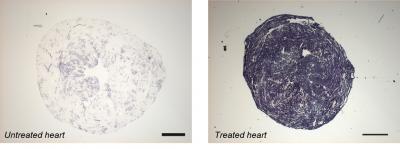The transfer, via a viral vector, of a normal copy of the gene deficient in patients, allowed to fully and very rapidly cure the heart disease in mice. These findings are published in Nature Medicine on 6 April, 2014.
Friedreich's ataxia is a severe, rare hereditary disorder which combines progressive neuro-degeneration, impaired heart function and an increased risk of diabetes. The condition affects one in every 50,000 birth. There is currently no effective treatment for this disease. In most cases, Friedreich's ataxia starts in adolescence with impaired balance and coordination (ataxia) of voluntary arm and leg movements, confining the majority of patients to a wheelchair after 10-20 years' progression. However, complications affecting the heart are the major cause of death in 60% of patients, most often before the 35 years of age.
The disease is caused by a common mutation in the FXN gene which leads to a dramatic decrease in the production of the protein named 'frataxin'. The reduced frataxin level disturbs the activity of mitochondria. These organelles are essential to cells and play a fundamental role in energy production. The nerve tissue (cerebellum, spinal cord etc.) and heart tissue are particularly vulnerable to this shortage of energy, which can lead to fatal heart failure.
The teams led by Hélène Puccio, director of research at Inserm and Patrick Aubourg have developed a therapeutic approach based on the use of an adeno-associated virus (AAV)[1], which is known to efficiently target and express a therapeutic gene in heart cells. The virus was modified to make it harmless but nevertheless capable of introducing a normal copy of the FXN gene in the heart cells, thus leading to the expression of frataxin.

The illustrations show a measurement of the activity of a mitochondrial protein (in blue) essential for cellular energy production, which is impaired when frataxin is absent (no staining in the untreated heart). Using gene therapy expressing frataxin, the activity of this essential protein can be corrected across the heart's entire surface.
(Photo Credit: © Inserm / H. Puccio)
Hélène Puccio's team tested the efficacy of this treatment in a mouse model that faithfully reproduces the heart symptoms of patients suffering from Friedreich's ataxia. The results show that a single intravenous injection of AAVrh10 expressing frataxin is not only capable of preventing the development of heart disease in animals before the appearance of symptoms, but also, more impressively, of fully and rapidly curing the hearts of animals at an advanced stage of heart disease. After three weeks of treatment, the heart become fully functional again; mitochondrial function and the appearance of heart tissue being very similar to those of healthy mice. "This is the first time that gene therapy has prompted full, lasting remission of heart disease so quickly in an animal model." explains Hélène Puccio.
As the central nervous system is also a target of AAV vectors, Hélène Puccio and Patrick Aubourg's teams are investigating whether a similar approach using gene therapy could be as effective for the spinal cord and cerebellum as it is for the heart.
Based on these promising results, work has begun on the necessary developments to propose to patients suffering from Friedreich's ataxia and presenting a progressive cardiomyopathy a treatment by gene therapy. To this end, three of the paper's authors have set up AAVLife, a French company specialising in gene therapy for rare diseases, to translate to clinic these important laboratory findings. A patent application has been submitted by Inserm Transfert for this gene therapy approach.
Source: INSERM (Institut national de la santé et de la recherche médicale)